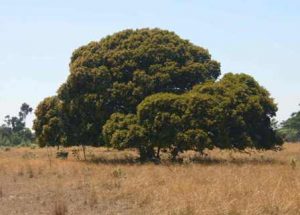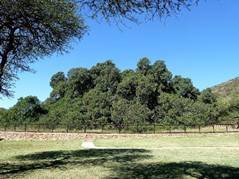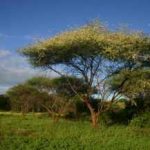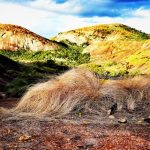TREE LIFE
April 2010
MASHONALAND CALENDAR
Sunday, April 18th: Lanark Game Park
This month, Dave Hartung will lead us on an exploration of Lanark Game Park, a short distance outside Harare.
The Lanark picnic site has been reserved for our use, so please bring some water, chairs (just in case) and a packed lunch.
The Threat to MacDonald Park
A development project – a joint venture between the City of Harare and Homelux Development – has been proposed for the site of MacDonald Park in Avondale, where there are numerous mature msasa trees, an undocumented amount of other natural vegetation and a city swimming pool. In an exploratory meeting at the end of March, the development was described by one of the promoters as ‘the most exciting thing Zimbabwe has had since Borrowdale Brooke’. The same meeting however also revealed that there is deep confusion as to the actual nature of the development.
The [classic] argument from the developers is that the pool and park are not being used by residents, and the City does not have enough money to get the pool running again and maintained. The development concept seems likely to involve the site becoming a business for the exclusive use of the rich elite. In addition, there is a complete lack of clarity regarding the environmental damage that would be caused.
It will cost only some $2500 to get the pool pump working again. Thus the MacDonald Park Conservation and Management Committee are launching a fundraising effort to get the pool viable again and to help save the park and turn it into something a bit more user-friendly. If you are willing to assist the Committee towards this goal, please contact the chair, Anna Brazier at abrazier@mango.zw
Mark has suggested that, upon his return from Madagascar, several of us from the Tree Society should organise an afternoon visit to MacDonald Park in order to record the plants and the trees likely to be threatened and to serve as a crosscheck on any environmental impact assessment. Volunteers can contact either me or Mark.
I have the full minutes of the meeting of 31st March and am happy to forward them to anyone interested.
Tree Lore—The Elder
In contrast with last month’s mainly positive associations with the Ash, the Elder has a generally much more sinister set of associations:
• It was a British belief that placing a child in an elder-wood cradle could cause it to be pinched black and blue by fairies.
• Elder flowers were feared – Fen people thought that if the scent were inhaled for long, a deep coma and then death would follow.
• Branches of elder were buried with the dead to protect them from evil spirits.
• Elder-wood was used for the whip handles of hearse drivers.
• The English believed that burning elder logs brought the devil into the house.
• The elder is associated with witches, who are said to sometimes disguise themselves as elder trees.
• It is said to be unlucky to break off an elder twig. One was supposed to ask permission of the elder tree or bush before pruning it, and to spit three times before cutting.
Farewell to Bernard and Nome
It is with sadness that we bid farewell to Bernard and Nome Beekes on the eve of their departure for the UK, under the scheme sponsored by the British Government. Bernard has been an active member of the Tree Society in so many ways, and we have enjoyed his reporting on expeditions far and wide. And Bernard and Nome have been such regular attendees at Society outings that it is hard to imagine an outing without them. Godspeed and safe landings.
A Request for Assistance
Inspired by what I have found in my search for nuggets of tree lore to use in Tree Life, I have been struck by the depth of readily accessible material on European tree species … and an apparent dearth of comparable material for African trees. I have thus decided to begin work on an anthology of the ‘cultural life of trees’ – tree lore, myths, legends and beliefs about trees in Zimbabwe specifically, and perhaps southern Africa more generally.
I thought at first ‘sacred trees’ would convey the idea, but it really does not describe what I am doing and actually gives the wrong idea. ‘Sacred’ in the sense of ‘not to be violated’ does fit with some of the cultural taboos around Zimbabwean trees – but certainly not all. ‘Trees of myth and legend’ was another possibility, but ‘legendary trees’ and ‘mythical trees’ are both subject to misinterpretation, as are ‘taboo trees’. I am not interested in individual trees, especially stories of the kind about who was hanged from which tree. It is tree species that interest me. The kind of thing that led the Romans to adopt oak leaves as a symbol of strength, a legacy that continues in contemporary German and American military decorations. Suggestions for titles are most welcome.
I need your help in two other ways. The obvious first one is written source materials. Coates-Palgrave contains a fair amount of useful material. Just some of the trees that have interesting practices associated with them include: baobabs, Afzelia quanzensis, Securidaca longipedunculata, Bridelia mollis, Acacia polyacantha, Dichrostachys cinerea, Sclerocarya birrea, Cassine matabelica, Hippobromus pauciflorus, Diospyros mespiliformis, Kigelia africana (a charm against whirlwinds!), Umtiza listeriana, and many others.
Similarly, I suspect there may be a good bit to be found in Michael Gelfand’s writings—at least on medical uses of trees, but I have not yet looked at these. I do know he deals with Parinari curatellifolia as used in rain-seeking ceremonies.
Hubert Bucher in his book on Shona cosmology also treats Parinari curatellifolia both as central in some rain-making ceremonies and as having prodigious powers of fertility. But both Bucher and Michael Bourdillon note that ecology is dominant and that ‘almost any tree will do’ for rain-making ceremonies, particularly if it is large and has bark lighter than average … hence the use of baobab in some areas.

Parinari curatellifolia. Photo: Burt Wursten, Source: Flora of Zimbabwe
In an effort to go as far back as possible, I have also looked at some of Peter Garlake’s work on San art to see what I could learn about the way trees were visualized in rock art, but the emphasis so far seems to be on artistic techniques rather than symbolism and interpretation.
So I would welcome pointers to any written source materials that might provide useful information.
Second, I am looking for good stories. Just by way of example, the story was passed along to me via an old gardener from Matabeleland that if you burn the wood of the rain tree (Lonchocarpus capassa) in your fire, then your village will be destroyed! But that is only half the story. Why? What is it about the tree that should result in such a dire fate? And has it ever happened? Coates-Palgrave notes that L. capassa is very prone to superstitious beliefs because it is a ‘rain tree’. What I would like to have is stories that go back to the origins of the beliefs where possible.
Please send all materials/suggestions to me at: bkinsey@mango.zw.
Many thanks.
-Ed.
The Long Walk to Freedom: A tale of the African savanna
The road to becoming a large tree in an African savannah is fraught with danger. Every tree that stands towering over the landscape has managed to overcome almost insurmountable odds in a battle against the most formidable of opponents. Understanding the victory, a tall majestic tree represents adds a new dimension to one’s appreciation. Along the course of a tree’s journey from seedling through sapling to adult, it must survive and overcome constant bombardment from a diversity of mammalian aggressors, frequent fire and competition from their seemingly humble, yet inescapable, opponent – grass.
The journey begins when a seed is lucky enough to escape its numerous predators and arrive at a site where the environment is just right for it to germinate. A newly established seedling stands little chance of surviving in the brutal playing fields of the African savannah. Having access to available water is crucial if a seedling is to grow and survive. However, rainfall in savannah regions is notoriously variable, which results in water shortages that kill both seedlings and larger trees – especially in the more arid savannahs. As well as a natural shortage of water, seedlings face the additional stress of having to compete with grasses for any that is available. Savannahs are defined by the co-existence of trees and grasses, and thus a savannah tree must necessarily live side by side with grass. Although grasses may seem rather feeble opponents, their roots can monopolize access to available water and nutrients, leaving few gaps for tree seedlings to occupy.
Living alongside grasses poses another threat to trees that challenges not only seedlings but saplings (trees shorter than 2 m) as well. When grasses grow in environments that experience seasonal drought, as do savannahs, the inevitable fires that occur threaten the survival of trees. Fires are regular disturbances in savannahs that become more frequent and of higher intensity the more grass there is. Trees with canopies below flame height inevitably succumb to fire. This means that once a seedling establishes itself, it enters a race to grow beyond the flames’ reach before the next fire passes through. In wetter, fertile savannahs where grass growth is rapid, fires can occur as frequently as every second year, or even annually, and their flames can scorch canopies up to 3 m. Consequently, a tree may have to grow between two and three metres in just a year or so in order to survive, which means that only the fittest and the fastest manage to escape from fires.
Yet it is not all over for those unlucky, or unfit, enough not to escape fire. Savannah trees are not hapless victims of the external forces that threaten to eliminate them. Many species have the remarkable ability to re-sprout from their roots and underground storage organs after the loss of stems, shoots and leaves to fire. The below-ground component of saplings can be vast, allowing trees many attempts at growing beyond the reach of fire and out of the ‘fire trap’. This spectacular battle between trees – latent giants held down by the chains of fire – and grass – the diminutive but nonetheless potent adversary – has been likened to the imprisonment of Jonathan Swift’s famous literary figure Gulliver by a mob of tiny Lilliputians. Savannah tree saplings have thus come to be known colloquially as ‘Gullivers’.
Despite these apparent fights for supremacy, savannah trees are also dependent on grass and fire for their continued existence. In the absence of fire, rather than becoming dominated by savannah trees, the environment is often invaded by fire-sensitive forest and thicket tree species. These ‘invaders’ can exclude both savannah trees and grasses and, through continued thickening and expansion, can result in the phenomenon known as ‘bush encroachment’. So there is no option for a tree other than to face the challenges posed by grass competition and fire, while at the same time confronting another hurdle: herbivores.
Large herbivores are a spectacular feature of African savannahs, and they occur in a variety of shapes and sizes, each with its own particular strategy for meeting its dietary needs. Some, such as impala and duiker, remove individual shoots and leaves, selecting only the plant parts they desire with great dexterity. Others, like giraffe and elephant, are less delicate as they need to consume vast amounts of forage to meet their nutritional requirements. This constant attrition results in trees losing large quantities of photosynthetic tissue and valuable nutrients to browsers, and acquiring densely branched hedge-like shapes – as if pruned by a clumsy gardener. The upshot is that growth is slowed and trees must spend more time within the reach of fire, increasing their chances of falling victim to it.
However, as anyone who has ever caressed an acacia will know, savannah trees have evolved ingenious and menacing defences to protect themselves against browsers. Long, sharp thorns protrude from the branches of many, piercing the mouth of any herbivore that approaches without caution. Other trees defend themselves chemically rather than mechanically, with toxic or unpalatable compounds in their leaves. Despite these various and many protections, most trees are not completely successful at preventing browsing, but they do however slow down and reduce herbivory sufficiently to survive. Some are successful enough to survive and grow beyond the grasp of both fire and even the tallest of herbivores.
Having made the remarkable journey from seedling to sapling (perhaps many times over) and on to adult, a savannah tree is now finally safe and secure from most of the perils it faced when it was smaller. Grass no longer poses a threat to its continued survival, it has access to deeper, more reliable water sources, and it is almost invulnerable to even the hottest fires. Moreover, it has grown too large to be reached by most browsers, and it can now spread its branches and bathe its leaves in sunlight. Despite this apparent fortification, even the largest tree cannot resist an assault from a fully grown African elephant. With enough effort, almost any stem can be snapped or tree toppled over. Failing that, sufficient bark can be stripped off the stem by tusks to ultimately stress the tree beyond recovery. It’s then back to the beginning to attempt the journey once more.
The tremendous achievement that a fully grown, towering tree rising above the savannah represents should not go unappreciated. Its existence is a most improbable event, and it deserves tremendous respect.
[Adapted and published in the interests of science from the original article by Glenn Moncrieff in the March 2010 issue of Veld & Flora.]Famous Trees of Africa

The Wonderboom (Wonder Tree; Miracle Tree) is a wild, willow-leaf fig Ficus salicifolia. Just outside Pretoria, R.S.A. Photo: Wikipedia
The Wonderboom (Wonder Tree; Miracle Tree) is a wild, willow-leaf fig (Ficus salicifolia) tree which is the centre of attraction in the kilometre-square Wonderboom Nature Reserve in Pretoria. Legend has it that the more-than-1,000-year-old tree grew so big as beneath its roots lies buried a native tribal chief. The tree, which was discovered in 1836, was once reported to be big enough to shade 1,000 people at a time. The tree’s lax branches have grown longer; drooping so that they touch the ground, where they have rooted and produced daughter trees that now surround the original tree over a vast area. The tree is considered unusual in several respects. One is that natural layering is not typical of the species so such an enormous tree complex is rare. Another is that Ficus salicifolia seldom grows taller than 9 m, while the Wonderboom stands at more than 23 m.



